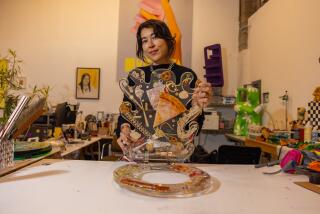Mocked Turtle : Throughout History, Artists Have Tried--and Failed--to Give This Reptile Nobility
- Share via
A tortoise is a turtle but a turtle is not a tortoise. I’m sorry if that sounds like something out of Gertrude Stein, but it’s the gospel truth. Tortoises are members of the turtle family, but they are terrestrial (except in Australia, where all freshwater turtles are called tortoises.) Turtles like flopping about in the briny, though they sometimes waddle ashore.
I have never been able to understand why either of these unjazzy, unthrilling creatures is so often used as a motif in the decorative arts. Examples range from a sumptuous silver centerpiece of spitting tortoises, made by the French firm Christofle in the 1920s, to a bronze-colored “turtle faucet” that Geary’s sells to fit onto the end of an ordinary garden hose. Perhaps it is because the tortoise is so reassuringly static that he is thought suitable as a design for ashtrays and tobacco jars.
One historic tortoise was all too fast--the one that landed on the head of Aeschylus from the air in 456 BC and killed him. One might say that this was the tortoise that put the “pace” into “carapace.” It was dropped by a passing eagle who mistook the dramatist’s bald pate for a rock, on which he intended to smash the tortoise’s shell so as to devour the succulent contents. That, at least, is what history tells, though I believe that some god or goddess, envious of Aeschylus’ genius, mounted the precision bombing raid in the guise of an eagle. As it happens, history had to wait for Lord Baden-Powell, the founder of the Boy Scout movement, for the advice that might have saved Aeschylus: “Be prepared.”
Otherwise, one does not associate high velocity with tortoises. Browning’s lines--”I sprang to the stirrup, and Joris, and he; / I galloped, Dirck galloped, we galloped all three . . .”--would lose some of their dramatic force if one discovered that the three heroes were spurring on tortoises. But men have ridden tortoises, and turtles, too. The Dutch artist Maarten van Heemskerck depicted Patience on a tortoise. Riding giant tortoises was a popular sport in Hagenbeck’s Zoological Gardens, Hamburg, in the early years of this century.
But there is also a tradition of much more sedentary tortoises, including the rather odd convention by which virtuous women were depicted standing on tortoises. This interpretation of the tortoise comes from Plutarch, who tells us that “Phidias made a statue of Aphrodite at Elis with one foot on a tortoise as a symbol that women should stay at home and be silent.” No women’s-libber, Phidias.
Another figure standing on a tortoise is the cherub who holds up a Victorian spoon warmer made of britannia metal. Spoons were warmed in hot water to stop the gravy from congealing on them, though the ribald legend persists that the real need for warm spoons was to reposition ladies’ breasts that had burst from the low decolletage of the time. An old and anonymous limerick runs:
Each time Lady Murga troyd swoons,
Her breasts pop out like balloons;
But her butler stands by
With a gleam in his eye
And pops them back in with warm spoons.
Turtles are supposed to be loving and loyal to their mates. But one kind of turtle, the snapping variety, is far from loving. William Edmondstoune Aytoun described an especially grisly specimen in his ballad, “The Fight with the Snapping Turtle; or, the American St. George” (1844):
. . . For a snout of huge dimensions
Rose above the waters high,
And took down the alli gator,
As a trout takes down a fly.
To the English, the turtle is best known as the ingredient of a delicious soup. Browning, describing the Mayor of Hamelin, wrote:
Nor brighter was his eye, nor moister,
Than a too-long-opened oyster,
Save when at noon his paunch grew mutinous
For a plate of turtle green and glutinous.
Tortoises and turtles have been converted into every kind of unsuitable artifact. Because of tortoises’ longevity, it was perhaps appropriate for them to lend their shapes to clocks. But bonbonnieres ? Barometers? Quite the nastiest thing done with a tortoise, and a living example at that, was described by cartoonist Osbert Lancaster in his memoirs. In the late 1920s, he saw the Australian-born Raniof Pudukota at Cannes, France, as she “watched her teen-age son with gilded toenails and made up to the nines, feeding asparagus tips to a pet tortoise with a diamond-encrusted shell.”
More to Read
The biggest entertainment stories
Get our big stories about Hollywood, film, television, music, arts, culture and more right in your inbox as soon as they publish.
You may occasionally receive promotional content from the Los Angeles Times.










